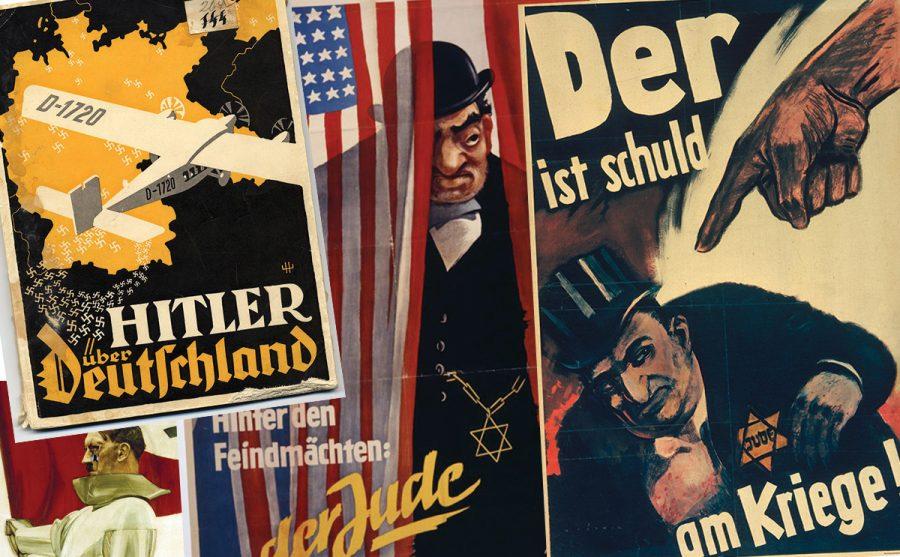Two exhibits depict Nazi prowess in spreading messages of hate
Published April 15, 2015
While it is tempting to dismiss Adolf Hitler and the Nazis of the Third Reich as deranged bigots, it is a matter of chilling historical fact that the Nazis were immensely skilled in the area of propaganda. All too skillfully, they used all available media to drive home their messages of hate and aggressive militarism.
Two powerful local exhibits illustrate just how effective the Nazis were in deploying a huge array of media — newspapers, popular magazines, radio programs, phonograph records, lurid posters and anti-Semitic cartoons — on the German public during the 12 years of the Third Reich.
The United States Holocaust Memorial Museum, based in Washington, D.C., has put together a major exhibition, “State of Deception: The Power of Nazi Propaganda,” which is appearing at the Missouri History Museum. A companion exhibit, “Capturing Minds: Images of Nazi Propaganda and Disinformation,” has been mounted by the St. Louis Holocaust Museum and Learning Center in the foyer of the Jewish Federation Kopolow Building.
The exhibits complement and reinforce each other with their compelling and often heart-stopping images of the diabolical tools Hitler and the National Socialist Party used to capture the hearts and minds of the German people and unsuspecting others around the world. All were seduced by the Nazi propaganda machine.
The local Holocaust Museum’s exhibit is smaller in scale and scope but no less powerful than the one at the History Museum. The viewer sees a quote by Hitler, stating that propaganda “tries to force a doctrine on the whole people.” The infamous Nuremberg Nazi Party rallies in which mobs of enthusiastic Germans were worked into a fever pitch are given as examples of how the Nazis consciously “fed the appetite for festivals, parades, rallies and demonstrations.”
Joseph Goebbels, Hitler’s minister of propaganda, orchestrated the various rallies and was a genius at using sound and light displays, including long columns of uniformed Nazis goose-stepping in unison, and the basic colors of the red, black and white Nazi flag as a means of infusing the German population with an ultranationalistic fervor.
Speaking admiringly of Goebbels, Hitler said, “Propaganda is a truly terrible weapon, especially in the hands of an expert.”
Indeed, Goebbels, who held a doctoral degree, combined total fanatic devotion to the Nazi cause with an expert appreciation of a multimedia approach to drive home the Nazi message.
The History Museum exhibit includes a variety of displays, videos, still photographs and multicolor posters. One of several short videos shows the rise of the Nazi Party in Germany from 1918, the year World War I ended with a humiliating defeat for Germany, to the events that led up to the decision by German President Paul von Hindenberg to name Hitler chancellor in January 1933. A voice-over explains that the video and other displays are designed to force the viewer to “look into the face of evil.”
Some of the posters in both exhibits show nose capitalists who manipulate leaders such as Franklin D. Roosevelt and Winston Churchill, who are depicted as warmongers controlled by the Jews of America and Great Britain. Other posters at the History Museum show vile-looking cartoons of Jews as being behind dishonest business practices or of being a danger to “Aryan” German children.
“Adolf Hitler was an avid student of propaganda and borrowed techniques from the Allies in World War I, his socialist and Communist rivals, the Italian Fascist Party, as well as modern advertising,” Steven Luckert, curator of the U.S. Holocaust Museum exhibit, said in a news release. “Drawing upon these models, he successfully marketed the Nazi Party, its ideology and himself to the German people.”
Among the tools of the Nazi propagandists were miniature magazines depicting “historic” achievements of the Nazi Party as it began to transform itself from an obscure, extremist group into the largest political party in Germany. The exhibit discusses how propaganda, combined with the use of terror, could help the party gain popular support. By adapting the ancient symbol of the swastika in emotive red, black and white as the movement’s flag, Hitler “established a potent visual identity that has branded the Nazi Party ever since.”
Included on display at the History Museum are “peoples’ radios,” which were distributed throughout Germany, except to Jews, and played nonstop Nazi programming. Also shown are phonograph records that were mass-produced and mailed to German households to drive home the party line on nationalism, aggression towards Germany’s neighbors and, of course, anti-Semitism.
One large poster shows a huge wheel in the shape of a swastika cutting the chains of the Versailles Treaty, which ended World War I. Some posters were printed in various versions, some targeting anti-Semites and others aimed at Germans who were nationalistic but not anti-Jewish.
Among the more disturbing images in the exhibits are those depicting the Hitlerjugend, or Hitler Youth, hundreds or thousands of exuberant, fresh-faced Nazi children carrying Nazi flags and wearing swastika armbands, swearing their undying allegiance to Hitler and the Nazi Party.
The St. Louis Holocaust Museum exhibit features an example of U.S. counter-propaganda against the Nazis. A full-color poster shows a young American boy wearing an outsize Nazi military hat, with the caption: “Is this your child? You don’t want this! Buy War Bonds!”
When Hitler joined the Nazi Party in 1919, it had a miniscule number of members. By the time he was named chancellor of Germany 14 years later, the party had the largest number of seats in the German Parliament. the Nazis burned down the Reichstag, or Parliament Building, and when German President Paul von Hindenberg died, Hitler took total dictatorial powers as “Der Fuhrer.”
His alarmingly rapid rise from obscurity to totalitarian control was in large part aided by the propaganda machine depicted in these exhibitions. They both deserve a large audience.
Where: Missouri History Museum
When: Through Sept. 7; 10 a.m. to 5 p.m. every day except Tuesday, when the museum closes at 8 p.m.
How much: Free
More info: mohistory.org or call 314-746-4599.
Companion exhibit at HMLC














